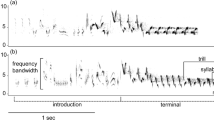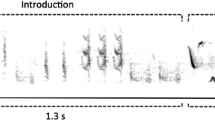Abstract
We analysed, for the first time, songs of the African Red-winged Starling Onychognathus morio and compared their general characteristics with those of the European Starling Sturnus vulgaris. Both species are gregarious during the non-breeding season, but European Starlings tend to nest in colonies, form unstable pair-bonds and are occasionally polygynous, whereas Red-winged Starlings form long-term pair-bonds and occupy exclusive nesting territories. Red-winged Starlings produced the same basic song categories as European Starlings: warbles and whistles. These two categories appeared to be involved in similar social interactions in the two species. However, several aspects of song behaviour differed between the two species: Red-winged Starlings, breeding in isolated nests, preferentially used whistles for long-distance communication and showed a simpler organization of warbling song. Whistles in the Red-winged Starling were mostly shared between birds and, in contrast to the European Starling, were not indicators of individual identity. Also in contrast to the European Starling, female song in Red-winged Starlings appeared very important throughout the breeding period. Our results suggest that some song characteristics in the two species are phylogenetically conserved whereas others are affected by the distinct social systems of the two species.



Similar content being viewed by others
References
Adret-Hausberger M (1983) Variations dialectales des sifflements des étourneaux sédentaires en Bretagne. Z Tierpsychol 62:55–71. doi:10.1111/j.1439–0310.1983.tb02141
Adret-Hausberger M (1984) Seasonal variation in the whistles of starlings Sturnus vulgaris. Ibis 126:372–378
Adret-Hausberger M (1986) Temporal dynamics of dialects in the whistled songs of starlings. Ethol 71:140–152. doi:10.1111/j.1439-0310.1986.tb00579
Adret-Hausberger M (1988) Song differentiation and population structure: the example of whistled songs in an introduced population of European starlings Sturnus vulgaris in Australia. Ethol 79:104–115. doi:10.1111/j.1439-0310.1988.tb00704
Adret-Hausberger M (1989) The species repertoire of whistled song in the European starling: species-specific characteristics and variability. Bioacoustics 2:137–162
Adret-Hausberger M, Jenkins PF (1988) Complex organization of the warbling song in the European starling Sturnus vulgaris. Behav 107:138–156
Adret-Hausberger M, Güttinger HR, Merkel FW (1990) Individual life history and song repertoire changes in a colony of starlings. Ethol 84:265–280
Alström P (2001) The use of sounds in bird systematics. Introductory research essay no. 2. Uppsala/Dept Systematic Zoology, Evolutionary Biology Centre, Uppsala University
Baptista LF (1975) Song dialects and demes in sedentary populations of the white-crowned sparrow (Zonotrichia leucophrys nuttalli). Univ Calif Pub Zool 105:1–52
Becker PH (1982) The coding of species-specific characteristics in bird sound. In: Miller EH, Kroodsma DE (eds) Acoustic communications in birds. Academic, New York, pp 213–252
Beecher MD (1989) Signalling system for individual recognition: an information theory approach. Anim Behav 38:248–261
Beletsky LD (1983) Aggressive and pair-bond maintenance songs of female red-winged Blackbirds Agelaius phoeniceus. Z Tierpsychol 62:47–54. doi:10.1111/j.1439-0310.1983.tb02140
Bertin A, Hausberger M, Henry L, Richard-Yris MA (2007) Adult and peer influences on starling song development. Dev Psychobiol 49(4):362–74. doi:10.1002/dev.20223
Bertram B (1970) The vocal behaviour of the Indian Hill Mynah Gracula religiosa. Anim Behav Monog 3:79–192
Blumstein DT, Armitage KB (1997) Does sociality drive the evolution of communicative complexity? A comparative test with ground-dwelling sciurid alarm calls. Am Nat 150:179–200. doi:10.1086/286062
Boughey MJ, Thompson NS (1981) Song variety in the Brown Thrasher (Toxostoma rufum). Z Tierpsychol 56:47–58. doi:10.1111/j.1439-0310.1981.tb01283
Bremond JC (1968) Recherches sur la sémantique et les éléments vecteurs d’information dans les signaux acoustiques du rouge-gorge Erithacus rubecula. Terre Vie 2:109–220
Brooks RJ, Falls JB (1975) Individual recognition by song in white-crowned sparrows. III. Song features used in individual recognition. Can J Zool 53:1749–1761. doi:10.1139/z75-101
Brown ED, Farabaugh SM (1997) What birds with complex social relationships can tell us about vocal learning: vocal sharing in avian groups. In: Snowdon CT, Hausberger M (eds) Social influences on vocal development. Cambridge University Press, Cambridge, pp 98–127
Catchpole CK (1980) Sexual selection and the evolution of complex songs among common warblers of the genus Acrocephalus. Behaviour 74:149–166. doi:0.1163/156853980X00366
Catchpole CK, Komdeur J (1992) The song of the Seychelles Warbler Acrocephalus sechellensis an island endemic. Ibis 135:190–195. doi:10.1111/j.1474-919X.1993.tb02831
Catchpole CK, Slater PJB (2008) Bird song: biological themes and variations, 2nd edn. Cambridge University Press, New York
Craig AJFK, Feare CJ (2009) Family Sturnidae (Starlings). In: Del Hoyo J, Elliott A, Christie DA (eds) Handbook of the birds of the world, vol 14. Lynx Edicions, Barcelona
Craig AJFK, Hulley PE, Walter GH (1989) Nesting of sympatric red-winged and pale-winged starlings. Ostrich 60:69–74
Dunbar RIM (2003) The origin and subsequent evolution of language. In: Christiansen MH, Kirby S (eds) Language evolution. Oxford University Press, Oxford, pp 219–234
Eens M (1997) Understanding the complex song of the European Starling: an integrated ethological approach. Adv Stud Behav 26:355–434
Eens M, Pinxten R, Verheyen RF (1989) Temporal and sequential organization of song bouts in the European starling. Ardea 77:75–86
Eens M, Pinxten R, Verheyen RF (1991) Male song as a cue for mate choice in the European starling. Behav 116:1141–1147
Eens M, Pinxten R, Verheyen RF (1993) Function of song and song repertoire in the European Starling Sturnus vulgaris: an avian experiment. Behav 125:51–66
Falls JB, Krebs JR, McGregor PK (1982) Song matching in the great tit (Parus major): the effect of similarity and familiarity. Anim Behav 30(4): 997–1009. doi:10.1016/S0003–3472(82)80188 DOI:10.1016/S0003–3472%2882%2980188–7
Feare CJ (1984) The starling. Oxford University Press, Oxford
Feekes F (1982) Song mimesis within colonies of Cacicus cela: a colonial password? Z Tierpsychol 58:119–152
Forrest TG (1994) From sender to receiver: propagation and environmental effects on acoustic signals. Am Zool 34:644–654
Freeberg TM (2006) Social complexity can drive vocal complexity: group size influences vocal information in Carolina chickadees. Psychol Sci 17:557. doi:10.1111/j.1467-9280.2006.01743.x
Gentner TQ, Hulse SH (1998) Perceptual mechanisms for individual vocal recognition in European starlings, Sturnus vulgaris. Anim Behav 56:579–594. doi:10.1006/anbe.1998.0810
George I, Cousillas H, Richard JP, Hausberger M (2008) A potential neural substrate for processing functional classes of complex acoustic signals. PLoS One 3(5):e2203. doi:10.1371/journal.pone.0002203
Gill FB (1990) Ornithology. Freeman, New York
Greene E (1999) Toward an evolutionary understanding of song diversity in oscines. Auk 116:373–386
Hailman JP (1989) The organization of major vocalizations in the Paridae. Wilson Bull 101:305–343
Hamao S, Ueda K (2000) Simplified song in an island population of the bush warbler Cettia diphone. J Ethol 18:53–57. doi:10.1007/s101640070025
Hausberger M (1997) Social influences on song acquisition and sharing in the European Starling Sturnus vulgaris. In: Snowdon CT, Hausberger M (eds) Social influences on vocal development. Cambridge University Press, Cambridge, pp 129–156. doi:10.1017/CBO9780511758843.008
Hausberger M, Jenkins PF, Keene J (1991) Species-specificity and mimicry in bird song: are they paradoxes? A reevaluation of song mimicry in the European Starling. Behav 117:53–81
Henry L, Hausberger M (2001) Differences in the social context of song production in captive male and female European starlings. CR Biol 324: 1167–1174. doi:10.1016/S0764–4469(01)01394–4 DOI:10.1016/S0764–4469%2801%2901394–4
Henry L, Hausberger M, Jenkins PF (1994) The use of song repertoire changes with pairing status in male European starling. Bioacoustics 5:261–266
Henry L, Bourguet C, Coulon M, Aubry C, Hausberger M (2012) Sharing mates and nestboxes is associated with female ‘friendship’ in European starlings Sturnus vulgaris. J Comp Psychol. doi:10.1037/a0029975
Inman B (1986) Female vocalizations and their role in the avian breeding cycle. Ann NY Acad Sci 474:44–52. doi:10.1111/j.1749-6632.1986.tb27997
Jenkins PF (1978) Cultural transmission of song patterns and dialect development in a free-living bird population. Anim Behav 26(1):50–78. doi:10.1016/0003-3472(78), 900007-6
Kreutzer M (1979) Etude du chant chez le bruant zizi Emberiza cirlus: le répertoire, caractéristiques et distribution. Behav 71:191–321
Kroodsma DE (1976) Reproductive development in a female songbird: differential stimulation by quality of male song. Sci 192:574–575. doi:10.1126/science.192.4239.574
Kroodsma DE (1977) Correlates of song organisation among North American wrens. Am Nat 111:995–1008
Langmore NE (1998) Functions of duet and solo songs of female birds. Tree 13(4): 136–140. doi:10.1016/S0169–5347(97)01241 DOI:10.1016/S0169–5347%2897%2901241-X
Maestripieri D (1999) Primate social organization, gestural repertoire size and communication dynamics: a comparative study of macaques. In: King BJ (ed) The origins of language: what non-human primates can tell us. School of American Research, Santa Fe
McCombe K, Semple S (2005) Coevolution of vocal communication and sociality in primates. Biol Let 1:381–385. doi:10.1098/rsbl.2005.0366
McCracken KG, Sheldon FH (1997) Avian vocalizations and phylogenetic signal. Proc Natl Acad Sci 94:3833–3836
Naas I (2009) Song variation and population identity in an African bird: Onychognathus morio, the Red-Winged Starling. Internship report Master 2, University of Rennes 1
Nelson DA (1989) Song frequency as a cue for recognition of species and individuals in the field sparrow (Spizella pusilla). J Comp Psychol 103:171–176. doi:10.1037/0735-7036.103.2.171
Pavlova D, Pinxten R, Eens M (2005) Female song in European starlings: sex differences, complexity, and composition. Condor 107(3):559–569. doi:10.1650/0010-5422
Pavlova D, Pinxten R, Eens M (2007a) Seasonal singing patterns and individual consistency in song activity in female European starlings (Sturnus vulgaris). Behav 144(6):663–680
Pavlova D, Pinxten R, Darras VM, Eens M (2007b) Effects of nestboxes and males on female song activity in the European starling: an experimental study. Behav 144(10):1255–1271
Payne RB (1986) Bird songs and avian systematics. In: Johnston RF (ed) Current ornithology, vol 3. Plenum, New York, pp 87–126
Pollard KA, Blumstein DT (2012) Evolving communicative complexity: insights from rodents and beyond. Phil Trans R Soc B 367(1597):1869–1878. doi:10.1098/rstb.2011.0221
Powlesland RG (1983) Seasonal and diurnal variation in vocal behaviour of the South Island robin. New Zealand J Zool 10:225–232
Price JJ (2009) Evolution and life history correlates of female song in the New World blackbirds. Behav Ecol 20:967–977. doi:10.1093/beheco/arp085
Réthoré-Astalos B (2012) Functional importance of structural and sequential organisation in the Red-winged Starling song. Internship-report Master 2, University of Rennes 1
Richard JP (1991) Sound analysis and synthesis using a microcomputer. Bioacoustics 3:45.60
Robinson FN (1975) Vocal mimicry and the evolution of bird song. Emu 75:23–27
Rowan MK (1955) The breeding biology and behaviour of the Red-winged Starling Onychognathus morio. Ibis 97:663–705. doi:10.1111/j.1474-919X.1955.tb01926
Ryan MJ, Brenowitz EA (1985) The role of body size, phylogeny, and ambient noise in the evolution of bird song. Am Nat 126:87–100
Sandell MI, Smith HG (1997) Female aggression in the European Starling during the breeding season. Anim Behav 53:13–23
Searcy WA, Andersson M (1986) Sexual selection and song. Ann Rev Ecol Syst 17:507–533
Slabbekoorn H, Smith TB (2002) Bird song, ecology and speciation. Phil Trans R Soc Lond B 357:493–503. doi:10.1098/rstb.2001.1056
Slater PJB, Mann NI (2004) Why do the females of many birds species sing in the tropics? J Avian Biol 35:289–294. doi:10.1111/j.0908-8857.2004.03392
Sontag WA (1985a) Song and courtship of the Wattled Starling Creatophora cinerea. Malimbus 7:129–135
Sontag WA (1985b) Zur Funktion des Gesangs bei Sturniden (Staren). Luscinia 45:181–200
Sontag WA (1991) Habitatsunterschiede, Balzverhalten, Paarbildung und Paarbindung beim Lappenstar Creatophora cinerea. Acta Biol Benrodis 3:99–114
Sorjonen J (1983) Transmission of the two most characteristic phrases of the song of the thrush nightingale Luscina luscina in different environmental conditions. Ornis Scand 14:278–288
Stoddard PK (1996) Vocal recognition of neighbours by territorial passerines. In: Kroodsma DE, Miller EH (eds) Ecology and evolution of acoustic communication in birds. Cornell University Press, Ithaca, pp 356–374
Vallet E, Beme I, Kreutzer M (1998) Two-note syllables in canary songs elicit high levels of sexual display. Anim Behav 55:291–297
Wiley RH (2005) Individuality in songs of Acadian flycatchers and recognition of neighbours. Anim Behav 70:237–247. doi:10.1016/j.anbehav.2004.09.027
Zuccon D, Cibois A, Pasquet E, Ericson PGP (2006) Nuclear and mitochondrial sequence data reveal the major lineages of starlings, mynas and related taxa. Mol Phylogenet Evol 41:333–344. doi:10.1016/j.ympev.2006.05.007
Author information
Authors and Affiliations
Corresponding author
Additional information
Communicated by: Sven Thatje
Rights and permissions
About this article
Cite this article
Houdelier, C., Hausberger, M. & Craig, A.J.F.K. Songs of two starling species: common traits versus adaptations to the social environment. Naturwissenschaften 99, 1051–1062 (2012). https://doi.org/10.1007/s00114-012-0987-0
Received:
Revised:
Accepted:
Published:
Issue Date:
DOI: https://doi.org/10.1007/s00114-012-0987-0




